UCOL Student Success: A Guide to APA 6th Edition Referencing
VerifiedAdded on 2021/08/10
|35
|13721
|230
Homework Assignment
AI Summary
This document is a comprehensive guide to the American Psychological Association (APA) 6th edition referencing style, created by the UCOL Student Success Team in January 2015 and updated in March 2017. It provides a detailed overview of APA, explaining its purpose and importance in academic writing, including why referencing is crucial to avoid plagiarism and enable readers to locate sources. The guide covers both in-text citations, detailing how to cite different numbers of authors, and direct quotes, as well as how to create a reference list with examples for various sources like books, journal articles, internet sources, and various other types of information. The guide also includes specific examples for different types of sources and provides a list of two-letter state codes for the USA, and offers additional resources such as the APA manual and the APA style website for further information. This guide aims to assist students in properly referencing their work.
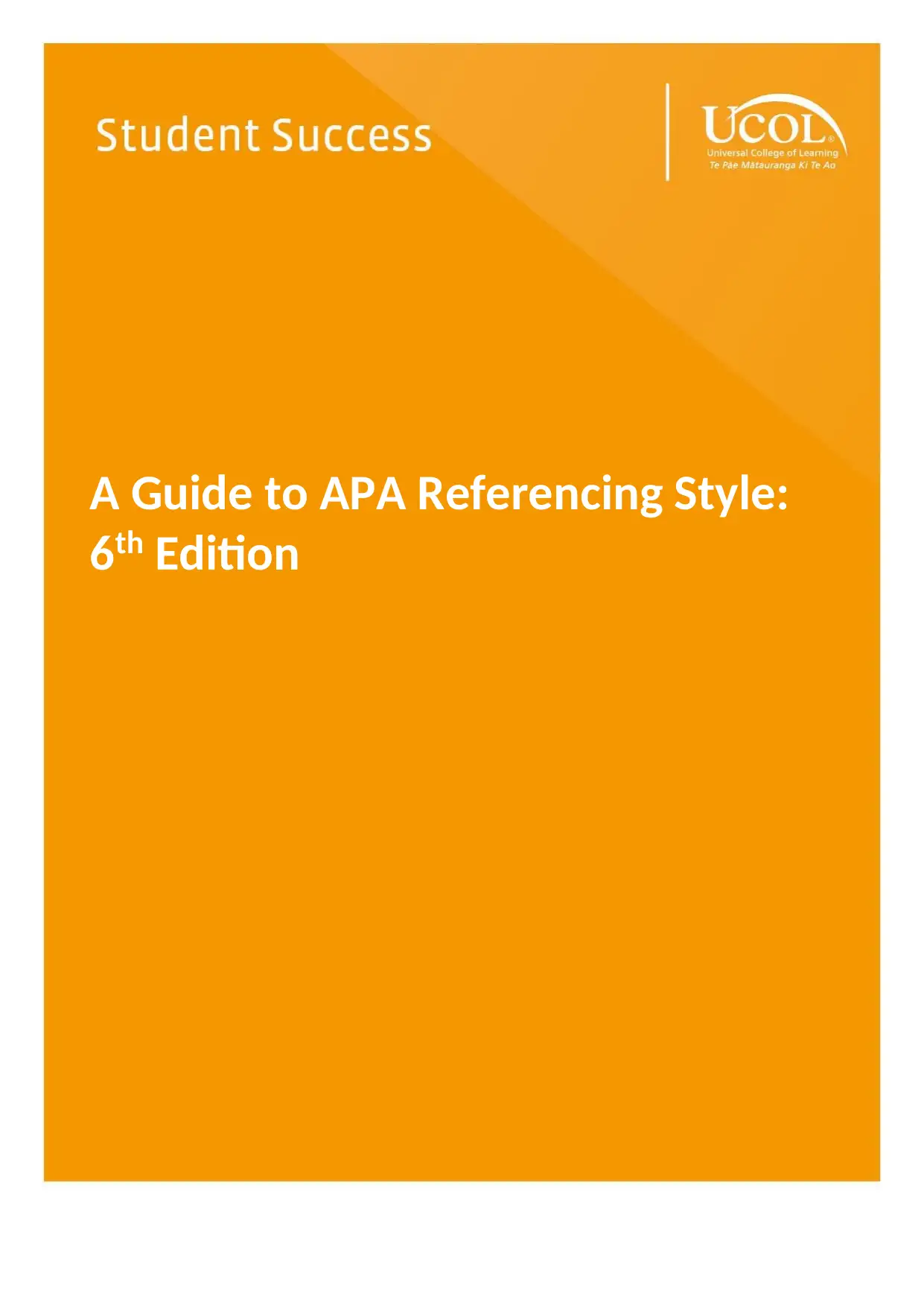
A Guide to APA Referencing Style:
6th Edition
6th Edition
Paraphrase This Document
Need a fresh take? Get an instant paraphrase of this document with our AI Paraphraser
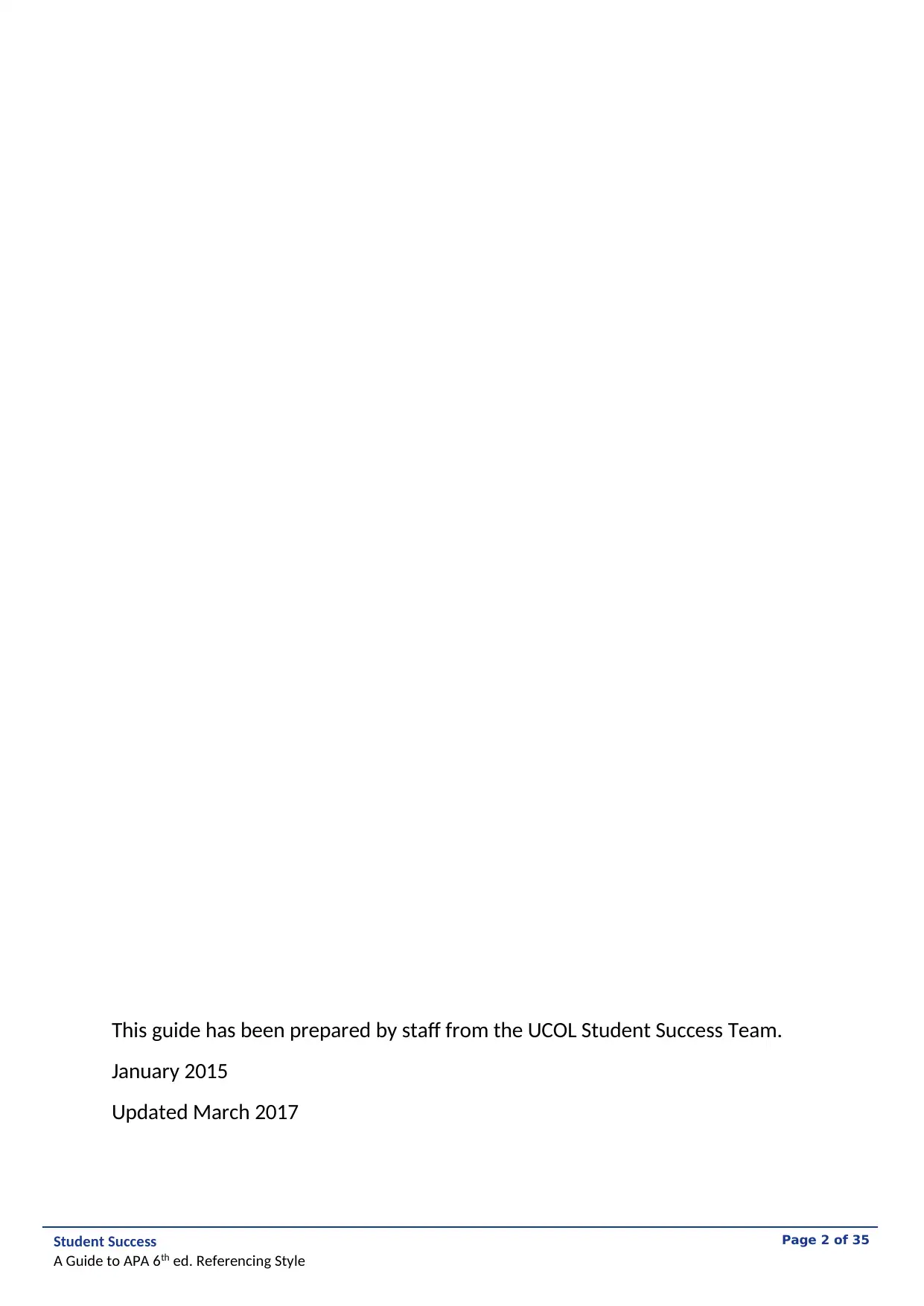
Student Success
A Guide to APA 6th ed. Referencing Style
Page 2 of 35
This guide has been prepared by staff from the UCOL Student Success Team.
January 2015
Updated March 2017
A Guide to APA 6th ed. Referencing Style
Page 2 of 35
This guide has been prepared by staff from the UCOL Student Success Team.
January 2015
Updated March 2017
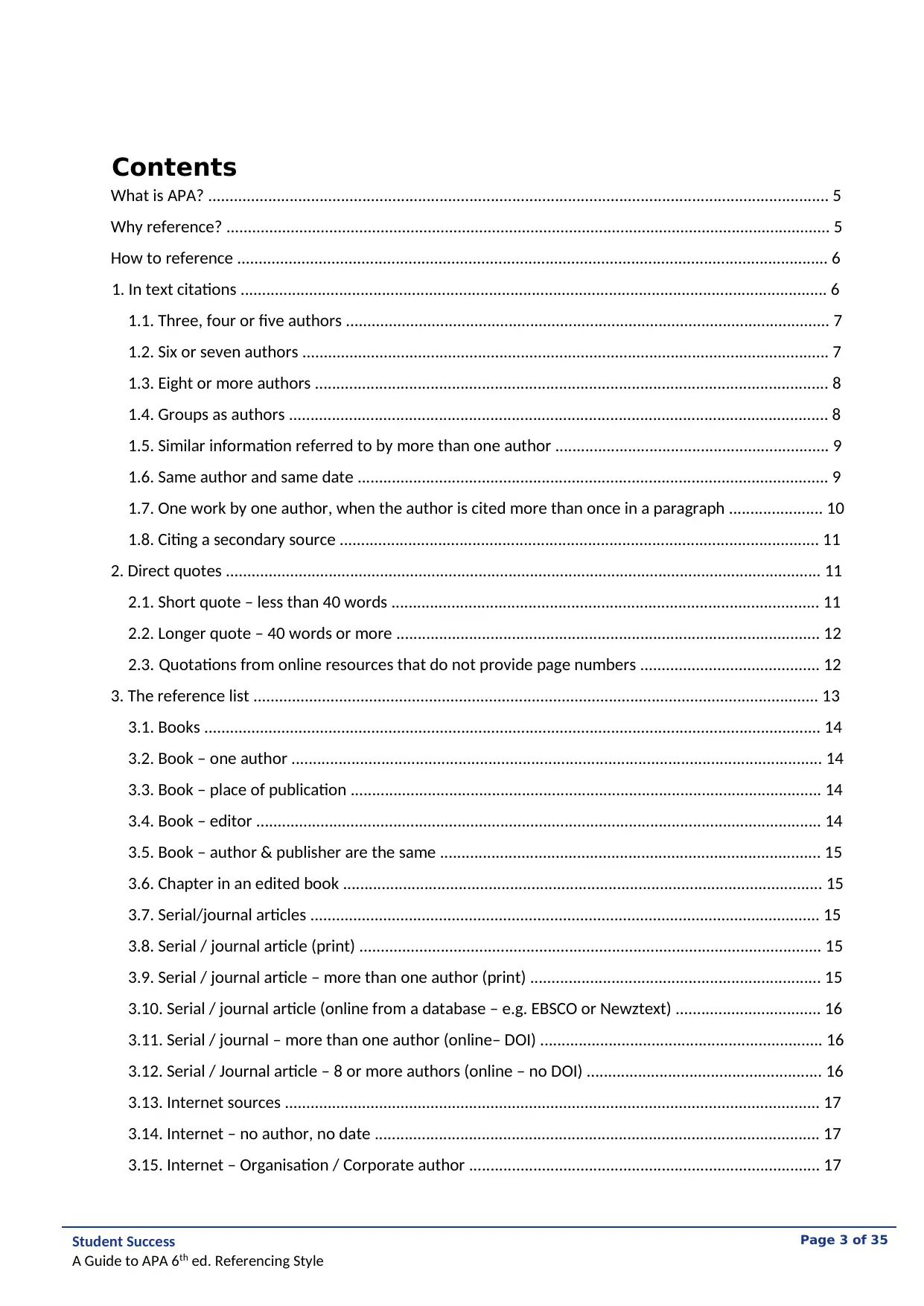
Student Success
A Guide to APA 6th ed. Referencing Style
Page 3 of 35
Contents
What is APA? ................................................................................................................................................. 5
Why reference? ............................................................................................................................................. 5
How to reference .......................................................................................................................................... 6
1. In text citations ......................................................................................................................................... 6
1.1. Three, four or five authors ................................................................................................................. 7
1.2. Six or seven authors ........................................................................................................................... 7
1.3. Eight or more authors ........................................................................................................................ 8
1.4. Groups as authors .............................................................................................................................. 8
1.5. Similar information referred to by more than one author ................................................................ 9
1.6. Same author and same date .............................................................................................................. 9
1.7. One work by one author, when the author is cited more than once in a paragraph ...................... 10
1.8. Citing a secondary source ................................................................................................................ 11
2. Direct quotes ........................................................................................................................................... 11
2.1. Short quote – less than 40 words .................................................................................................... 11
2.2. Longer quote – 40 words or more ................................................................................................... 12
2.3. Quotations from online resources that do not provide page numbers .......................................... 12
3. The reference list .................................................................................................................................... 13
3.1. Books ................................................................................................................................................ 14
3.2. Book – one author ............................................................................................................................ 14
3.3. Book – place of publication .............................................................................................................. 14
3.4. Book – editor .................................................................................................................................... 14
3.5. Book – author & publisher are the same ......................................................................................... 15
3.6. Chapter in an edited book ................................................................................................................ 15
3.7. Serial/journal articles ....................................................................................................................... 15
3.8. Serial / journal article (print) ............................................................................................................ 15
3.9. Serial / journal article – more than one author (print) .................................................................... 15
3.10. Serial / journal article (online from a database – e.g. EBSCO or Newztext) .................................. 16
3.11. Serial / journal – more than one author (online– DOI) .................................................................. 16
3.12. Serial / Journal article – 8 or more authors (online – no DOI) ....................................................... 16
3.13. Internet sources ............................................................................................................................. 17
3.14. Internet – no author, no date ........................................................................................................ 17
3.15. Internet – Organisation / Corporate author .................................................................................. 17
A Guide to APA 6th ed. Referencing Style
Page 3 of 35
Contents
What is APA? ................................................................................................................................................. 5
Why reference? ............................................................................................................................................. 5
How to reference .......................................................................................................................................... 6
1. In text citations ......................................................................................................................................... 6
1.1. Three, four or five authors ................................................................................................................. 7
1.2. Six or seven authors ........................................................................................................................... 7
1.3. Eight or more authors ........................................................................................................................ 8
1.4. Groups as authors .............................................................................................................................. 8
1.5. Similar information referred to by more than one author ................................................................ 9
1.6. Same author and same date .............................................................................................................. 9
1.7. One work by one author, when the author is cited more than once in a paragraph ...................... 10
1.8. Citing a secondary source ................................................................................................................ 11
2. Direct quotes ........................................................................................................................................... 11
2.1. Short quote – less than 40 words .................................................................................................... 11
2.2. Longer quote – 40 words or more ................................................................................................... 12
2.3. Quotations from online resources that do not provide page numbers .......................................... 12
3. The reference list .................................................................................................................................... 13
3.1. Books ................................................................................................................................................ 14
3.2. Book – one author ............................................................................................................................ 14
3.3. Book – place of publication .............................................................................................................. 14
3.4. Book – editor .................................................................................................................................... 14
3.5. Book – author & publisher are the same ......................................................................................... 15
3.6. Chapter in an edited book ................................................................................................................ 15
3.7. Serial/journal articles ....................................................................................................................... 15
3.8. Serial / journal article (print) ............................................................................................................ 15
3.9. Serial / journal article – more than one author (print) .................................................................... 15
3.10. Serial / journal article (online from a database – e.g. EBSCO or Newztext) .................................. 16
3.11. Serial / journal – more than one author (online– DOI) .................................................................. 16
3.12. Serial / Journal article – 8 or more authors (online – no DOI) ....................................................... 16
3.13. Internet sources ............................................................................................................................. 17
3.14. Internet – no author, no date ........................................................................................................ 17
3.15. Internet – Organisation / Corporate author .................................................................................. 17
⊘ This is a preview!⊘
Do you want full access?
Subscribe today to unlock all pages.

Trusted by 1+ million students worldwide
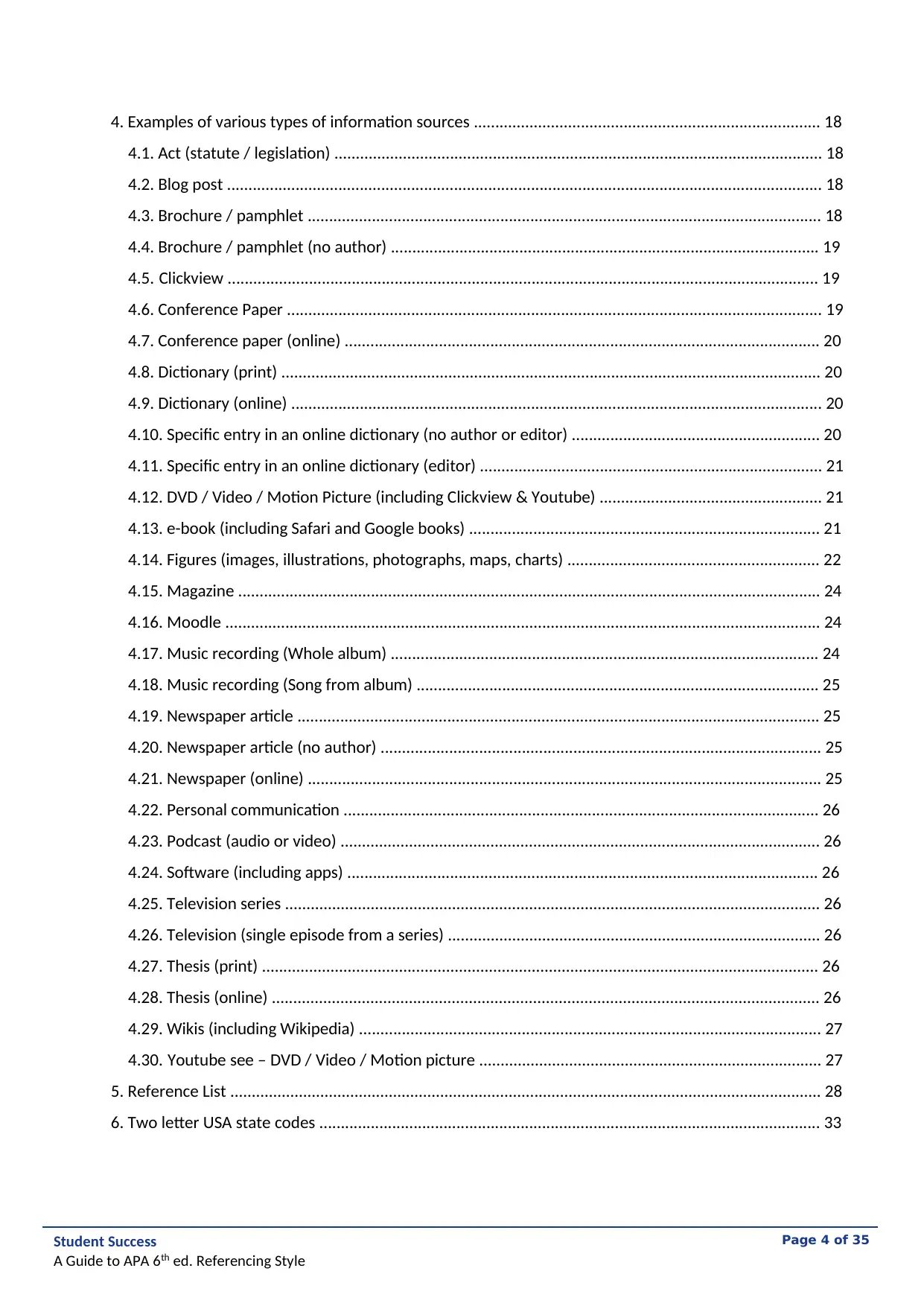
Student Success
A Guide to APA 6th ed. Referencing Style
Page 4 of 35
4. Examples of various types of information sources ................................................................................. 18
4.1. Act (statute / legislation) .................................................................................................................. 18
4.2. Blog post ........................................................................................................................................... 18
4.3. Brochure / pamphlet ........................................................................................................................ 18
4.4. Brochure / pamphlet (no author) .................................................................................................... 19
4.5. Clickview .......................................................................................................................................... 19
4.6. Conference Paper ............................................................................................................................. 19
4.7. Conference paper (online) ............................................................................................................... 20
4.8. Dictionary (print) .............................................................................................................................. 20
4.9. Dictionary (online) ............................................................................................................................ 20
4.10. Specific entry in an online dictionary (no author or editor) .......................................................... 20
4.11. Specific entry in an online dictionary (editor) ................................................................................ 21
4.12. DVD / Video / Motion Picture (including Clickview & Youtube) .................................................... 21
4.13. e-book (including Safari and Google books) .................................................................................. 21
4.14. Figures (images, illustrations, photographs, maps, charts) ........................................................... 22
4.15. Magazine ........................................................................................................................................ 24
4.16. Moodle ........................................................................................................................................... 24
4.17. Music recording (Whole album) .................................................................................................... 24
4.18. Music recording (Song from album) .............................................................................................. 25
4.19. Newspaper article .......................................................................................................................... 25
4.20. Newspaper article (no author) ....................................................................................................... 25
4.21. Newspaper (online) ........................................................................................................................ 25
4.22. Personal communication ............................................................................................................... 26
4.23. Podcast (audio or video) ................................................................................................................ 26
4.24. Software (including apps) .............................................................................................................. 26
4.25. Television series ............................................................................................................................. 26
4.26. Television (single episode from a series) ....................................................................................... 26
4.27. Thesis (print) .................................................................................................................................. 26
4.28. Thesis (online) ................................................................................................................................ 26
4.29. Wikis (including Wikipedia) ............................................................................................................ 27
4.30. Youtube see – DVD / Video / Motion picture ................................................................................ 27
5. Reference List .......................................................................................................................................... 28
6. Two letter USA state codes ..................................................................................................................... 33
A Guide to APA 6th ed. Referencing Style
Page 4 of 35
4. Examples of various types of information sources ................................................................................. 18
4.1. Act (statute / legislation) .................................................................................................................. 18
4.2. Blog post ........................................................................................................................................... 18
4.3. Brochure / pamphlet ........................................................................................................................ 18
4.4. Brochure / pamphlet (no author) .................................................................................................... 19
4.5. Clickview .......................................................................................................................................... 19
4.6. Conference Paper ............................................................................................................................. 19
4.7. Conference paper (online) ............................................................................................................... 20
4.8. Dictionary (print) .............................................................................................................................. 20
4.9. Dictionary (online) ............................................................................................................................ 20
4.10. Specific entry in an online dictionary (no author or editor) .......................................................... 20
4.11. Specific entry in an online dictionary (editor) ................................................................................ 21
4.12. DVD / Video / Motion Picture (including Clickview & Youtube) .................................................... 21
4.13. e-book (including Safari and Google books) .................................................................................. 21
4.14. Figures (images, illustrations, photographs, maps, charts) ........................................................... 22
4.15. Magazine ........................................................................................................................................ 24
4.16. Moodle ........................................................................................................................................... 24
4.17. Music recording (Whole album) .................................................................................................... 24
4.18. Music recording (Song from album) .............................................................................................. 25
4.19. Newspaper article .......................................................................................................................... 25
4.20. Newspaper article (no author) ....................................................................................................... 25
4.21. Newspaper (online) ........................................................................................................................ 25
4.22. Personal communication ............................................................................................................... 26
4.23. Podcast (audio or video) ................................................................................................................ 26
4.24. Software (including apps) .............................................................................................................. 26
4.25. Television series ............................................................................................................................. 26
4.26. Television (single episode from a series) ....................................................................................... 26
4.27. Thesis (print) .................................................................................................................................. 26
4.28. Thesis (online) ................................................................................................................................ 26
4.29. Wikis (including Wikipedia) ............................................................................................................ 27
4.30. Youtube see – DVD / Video / Motion picture ................................................................................ 27
5. Reference List .......................................................................................................................................... 28
6. Two letter USA state codes ..................................................................................................................... 33
Paraphrase This Document
Need a fresh take? Get an instant paraphrase of this document with our AI Paraphraser
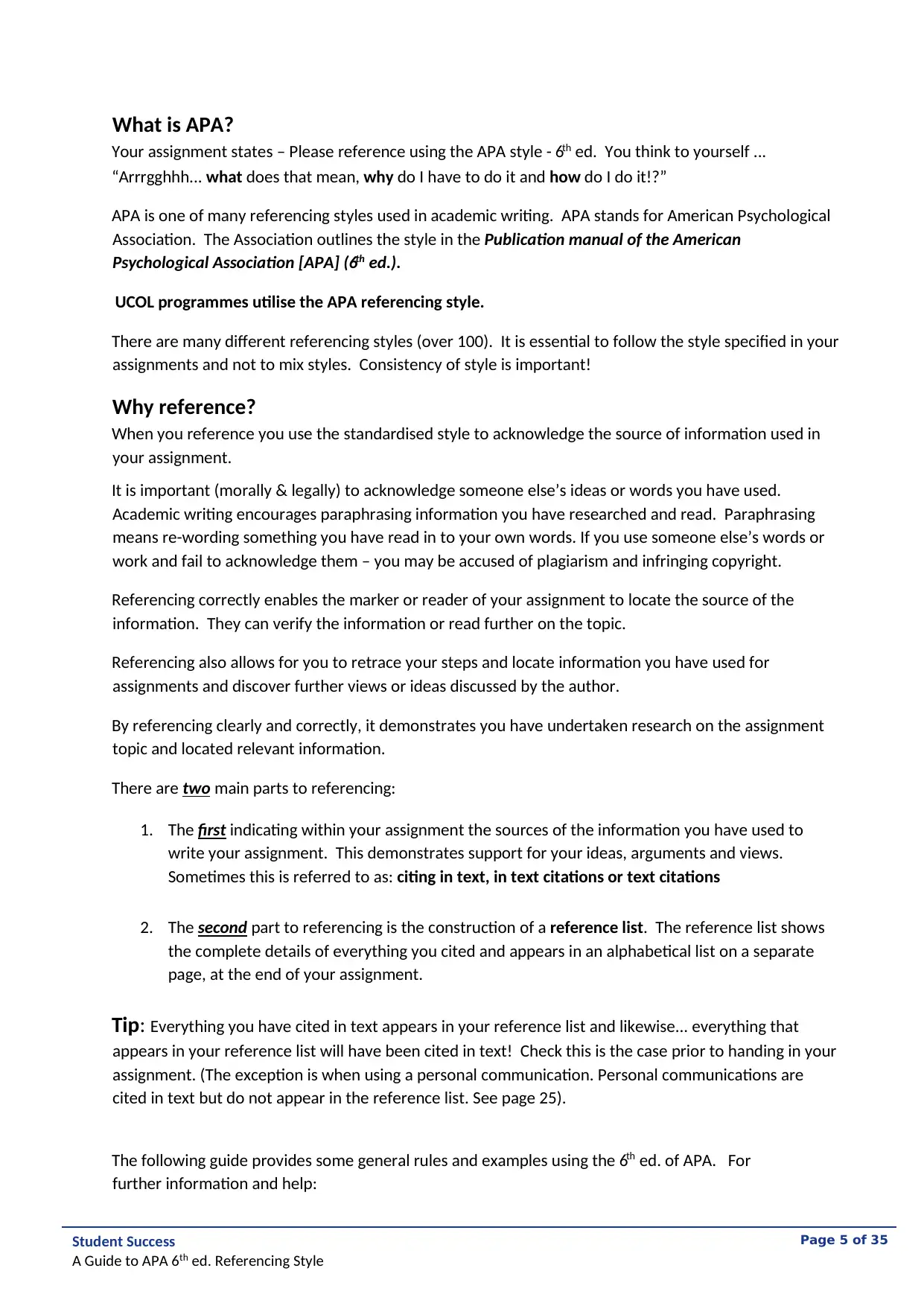
Student Success
A Guide to APA 6th ed. Referencing Style
Page 5 of 35
What is APA?
Your assignment states – Please reference using the APA style - 6th ed. You think to yourself ...
“Arrrgghhh... what does that mean, why do I have to do it and how do I do it!?”
APA is one of many referencing styles used in academic writing. APA stands for American Psychological
Association. The Association outlines the style in the Publication manual of the American
Psychological Association [APA] (6th ed.).
UCOL programmes utilise the APA referencing style.
There are many different referencing styles (over 100). It is essential to follow the style specified in your
assignments and not to mix styles. Consistency of style is important!
Why reference?
When you reference you use the standardised style to acknowledge the source of information used in
your assignment.
It is important (morally & legally) to acknowledge someone else’s ideas or words you have used.
Academic writing encourages paraphrasing information you have researched and read. Paraphrasing
means re-wording something you have read in to your own words. If you use someone else’s words or
work and fail to acknowledge them – you may be accused of plagiarism and infringing copyright.
Referencing correctly enables the marker or reader of your assignment to locate the source of the
information. They can verify the information or read further on the topic.
Referencing also allows for you to retrace your steps and locate information you have used for
assignments and discover further views or ideas discussed by the author.
By referencing clearly and correctly, it demonstrates you have undertaken research on the assignment
topic and located relevant information.
There are two main parts to referencing:
1. The first indicating within your assignment the sources of the information you have used to
write your assignment. This demonstrates support for your ideas, arguments and views.
Sometimes this is referred to as: citing in text, in text citations or text citations
2. The second part to referencing is the construction of a reference list. The reference list shows
the complete details of everything you cited and appears in an alphabetical list on a separate
page, at the end of your assignment.
Tip: Everything you have cited in text appears in your reference list and likewise... everything that
appears in your reference list will have been cited in text! Check this is the case prior to handing in your
assignment. (The exception is when using a personal communication. Personal communications are
cited in text but do not appear in the reference list. See page 25).
The following guide provides some general rules and examples using the 6th ed. of APA. For
further information and help:
A Guide to APA 6th ed. Referencing Style
Page 5 of 35
What is APA?
Your assignment states – Please reference using the APA style - 6th ed. You think to yourself ...
“Arrrgghhh... what does that mean, why do I have to do it and how do I do it!?”
APA is one of many referencing styles used in academic writing. APA stands for American Psychological
Association. The Association outlines the style in the Publication manual of the American
Psychological Association [APA] (6th ed.).
UCOL programmes utilise the APA referencing style.
There are many different referencing styles (over 100). It is essential to follow the style specified in your
assignments and not to mix styles. Consistency of style is important!
Why reference?
When you reference you use the standardised style to acknowledge the source of information used in
your assignment.
It is important (morally & legally) to acknowledge someone else’s ideas or words you have used.
Academic writing encourages paraphrasing information you have researched and read. Paraphrasing
means re-wording something you have read in to your own words. If you use someone else’s words or
work and fail to acknowledge them – you may be accused of plagiarism and infringing copyright.
Referencing correctly enables the marker or reader of your assignment to locate the source of the
information. They can verify the information or read further on the topic.
Referencing also allows for you to retrace your steps and locate information you have used for
assignments and discover further views or ideas discussed by the author.
By referencing clearly and correctly, it demonstrates you have undertaken research on the assignment
topic and located relevant information.
There are two main parts to referencing:
1. The first indicating within your assignment the sources of the information you have used to
write your assignment. This demonstrates support for your ideas, arguments and views.
Sometimes this is referred to as: citing in text, in text citations or text citations
2. The second part to referencing is the construction of a reference list. The reference list shows
the complete details of everything you cited and appears in an alphabetical list on a separate
page, at the end of your assignment.
Tip: Everything you have cited in text appears in your reference list and likewise... everything that
appears in your reference list will have been cited in text! Check this is the case prior to handing in your
assignment. (The exception is when using a personal communication. Personal communications are
cited in text but do not appear in the reference list. See page 25).
The following guide provides some general rules and examples using the 6th ed. of APA. For
further information and help:
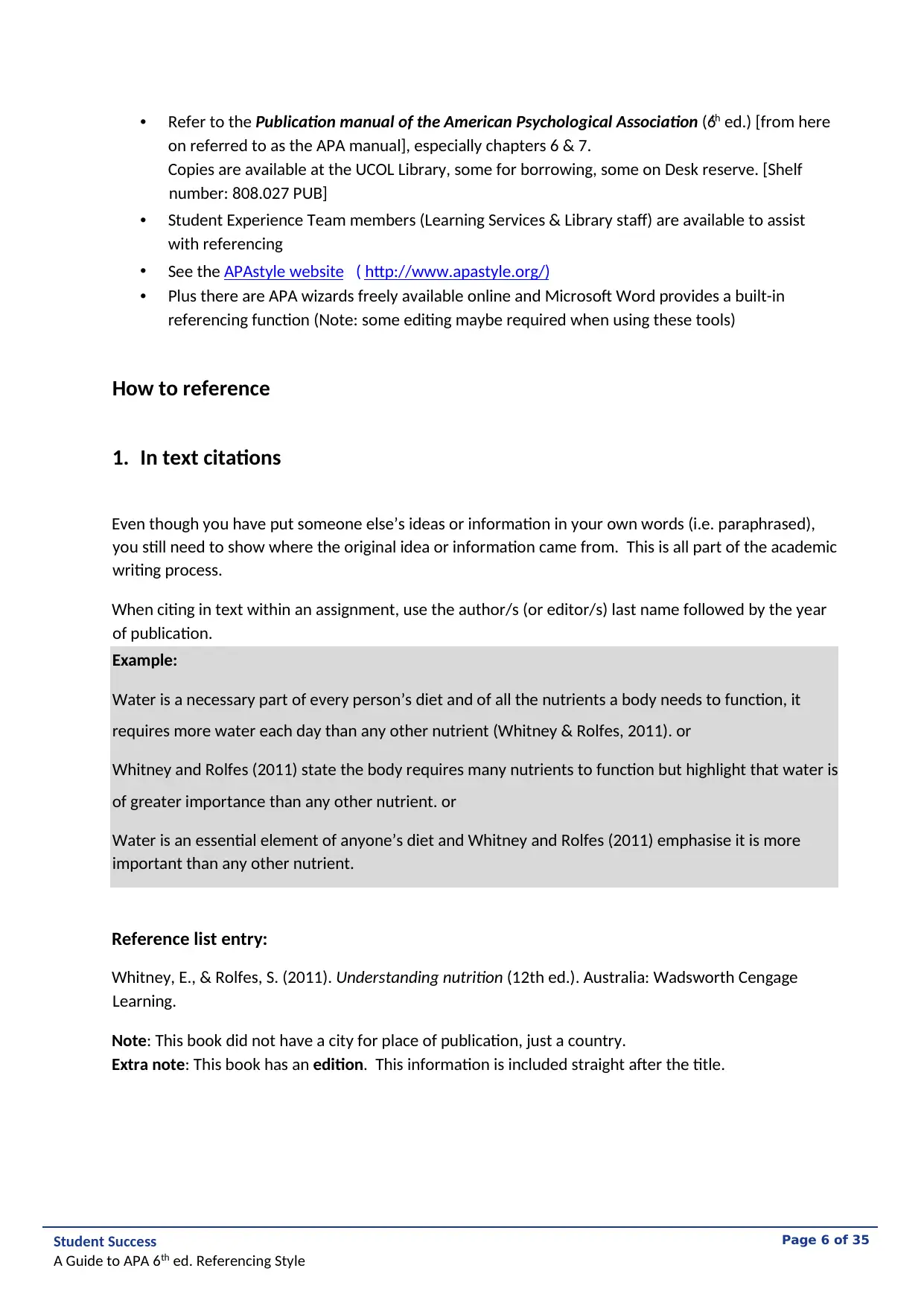
Student Success
A Guide to APA 6th ed. Referencing Style
Page 6 of 35
• Refer to the Publication manual of the American Psychological Association (6th ed.) [from here
on referred to as the APA manual], especially chapters 6 & 7.
Copies are available at the UCOL Library, some for borrowing, some on Desk reserve. [Shelf
number: 808.027 PUB]
• Student Experience Team members (Learning Services & Library staff) are available to assist
with referencing
• See the APAstyle website ( http://www.apastyle.org/)
• Plus there are APA wizards freely available online and Microsoft Word provides a built-in
referencing function (Note: some editing maybe required when using these tools)
How to reference
1. In text citations
Even though you have put someone else’s ideas or information in your own words (i.e. paraphrased),
you still need to show where the original idea or information came from. This is all part of the academic
writing process.
When citing in text within an assignment, use the author/s (or editor/s) last name followed by the year
of publication.
Example:
Water is a necessary part of every person’s diet and of all the nutrients a body needs to function, it
requires more water each day than any other nutrient (Whitney & Rolfes, 2011). or
Whitney and Rolfes (2011) state the body requires many nutrients to function but highlight that water is
of greater importance than any other nutrient. or
Water is an essential element of anyone’s diet and Whitney and Rolfes (2011) emphasise it is more
important than any other nutrient.
Reference list entry:
Whitney, E., & Rolfes, S. (2011). Understanding nutrition (12th ed.). Australia: Wadsworth Cengage
Learning.
Note: This book did not have a city for place of publication, just a country.
Extra note: This book has an edition. This information is included straight after the title.
A Guide to APA 6th ed. Referencing Style
Page 6 of 35
• Refer to the Publication manual of the American Psychological Association (6th ed.) [from here
on referred to as the APA manual], especially chapters 6 & 7.
Copies are available at the UCOL Library, some for borrowing, some on Desk reserve. [Shelf
number: 808.027 PUB]
• Student Experience Team members (Learning Services & Library staff) are available to assist
with referencing
• See the APAstyle website ( http://www.apastyle.org/)
• Plus there are APA wizards freely available online and Microsoft Word provides a built-in
referencing function (Note: some editing maybe required when using these tools)
How to reference
1. In text citations
Even though you have put someone else’s ideas or information in your own words (i.e. paraphrased),
you still need to show where the original idea or information came from. This is all part of the academic
writing process.
When citing in text within an assignment, use the author/s (or editor/s) last name followed by the year
of publication.
Example:
Water is a necessary part of every person’s diet and of all the nutrients a body needs to function, it
requires more water each day than any other nutrient (Whitney & Rolfes, 2011). or
Whitney and Rolfes (2011) state the body requires many nutrients to function but highlight that water is
of greater importance than any other nutrient. or
Water is an essential element of anyone’s diet and Whitney and Rolfes (2011) emphasise it is more
important than any other nutrient.
Reference list entry:
Whitney, E., & Rolfes, S. (2011). Understanding nutrition (12th ed.). Australia: Wadsworth Cengage
Learning.
Note: This book did not have a city for place of publication, just a country.
Extra note: This book has an edition. This information is included straight after the title.
⊘ This is a preview!⊘
Do you want full access?
Subscribe today to unlock all pages.

Trusted by 1+ million students worldwide
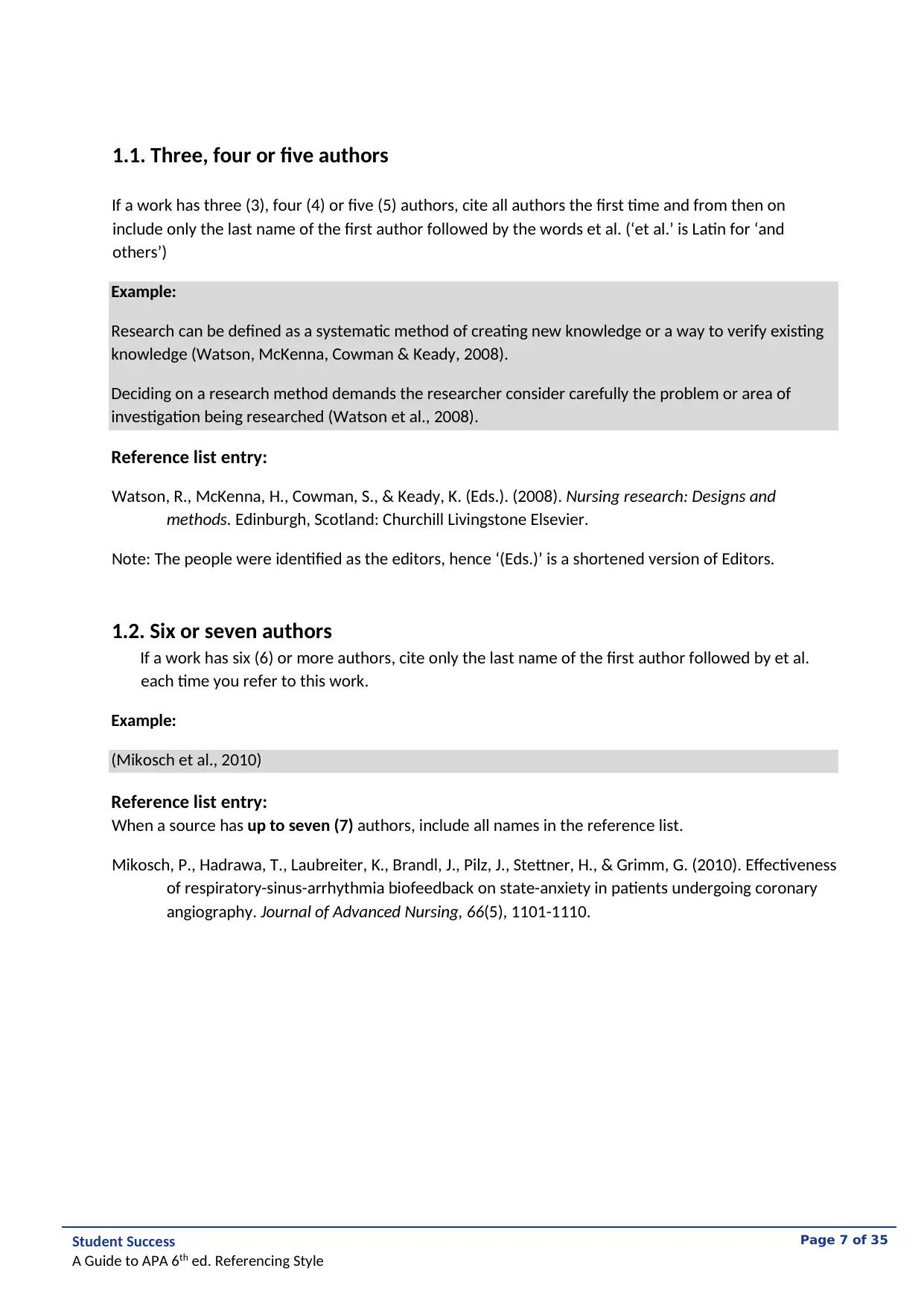
Student Success
A Guide to APA 6th ed. Referencing Style
Page 7 of 35
1.1. Three, four or five authors
If a work has three (3), four (4) or five (5) authors, cite all authors the first time and from then on
include only the last name of the first author followed by the words et al. (‘et al.’ is Latin for ‘and
others’)
Example:
Research can be defined as a systematic method of creating new knowledge or a way to verify existing
knowledge (Watson, McKenna, Cowman & Keady, 2008).
Deciding on a research method demands the researcher consider carefully the problem or area of
investigation being researched (Watson et al., 2008).
Reference list entry:
Watson, R., McKenna, H., Cowman, S., & Keady, K. (Eds.). (2008). Nursing research: Designs and
methods. Edinburgh, Scotland: Churchill Livingstone Elsevier.
Note: The people were identified as the editors, hence ‘(Eds.)’ is a shortened version of Editors.
1.2. Six or seven authors
If a work has six (6) or more authors, cite only the last name of the first author followed by et al.
each time you refer to this work.
Example:
(Mikosch et al., 2010)
Reference list entry:
When a source has up to seven (7) authors, include all names in the reference list.
Mikosch, P., Hadrawa, T., Laubreiter, K., Brandl, J., Pilz, J., Stettner, H., & Grimm, G. (2010). Effectiveness
of respiratory-sinus-arrhythmia biofeedback on state-anxiety in patients undergoing coronary
angiography. Journal of Advanced Nursing, 66(5), 1101-1110.
A Guide to APA 6th ed. Referencing Style
Page 7 of 35
1.1. Three, four or five authors
If a work has three (3), four (4) or five (5) authors, cite all authors the first time and from then on
include only the last name of the first author followed by the words et al. (‘et al.’ is Latin for ‘and
others’)
Example:
Research can be defined as a systematic method of creating new knowledge or a way to verify existing
knowledge (Watson, McKenna, Cowman & Keady, 2008).
Deciding on a research method demands the researcher consider carefully the problem or area of
investigation being researched (Watson et al., 2008).
Reference list entry:
Watson, R., McKenna, H., Cowman, S., & Keady, K. (Eds.). (2008). Nursing research: Designs and
methods. Edinburgh, Scotland: Churchill Livingstone Elsevier.
Note: The people were identified as the editors, hence ‘(Eds.)’ is a shortened version of Editors.
1.2. Six or seven authors
If a work has six (6) or more authors, cite only the last name of the first author followed by et al.
each time you refer to this work.
Example:
(Mikosch et al., 2010)
Reference list entry:
When a source has up to seven (7) authors, include all names in the reference list.
Mikosch, P., Hadrawa, T., Laubreiter, K., Brandl, J., Pilz, J., Stettner, H., & Grimm, G. (2010). Effectiveness
of respiratory-sinus-arrhythmia biofeedback on state-anxiety in patients undergoing coronary
angiography. Journal of Advanced Nursing, 66(5), 1101-1110.
Paraphrase This Document
Need a fresh take? Get an instant paraphrase of this document with our AI Paraphraser
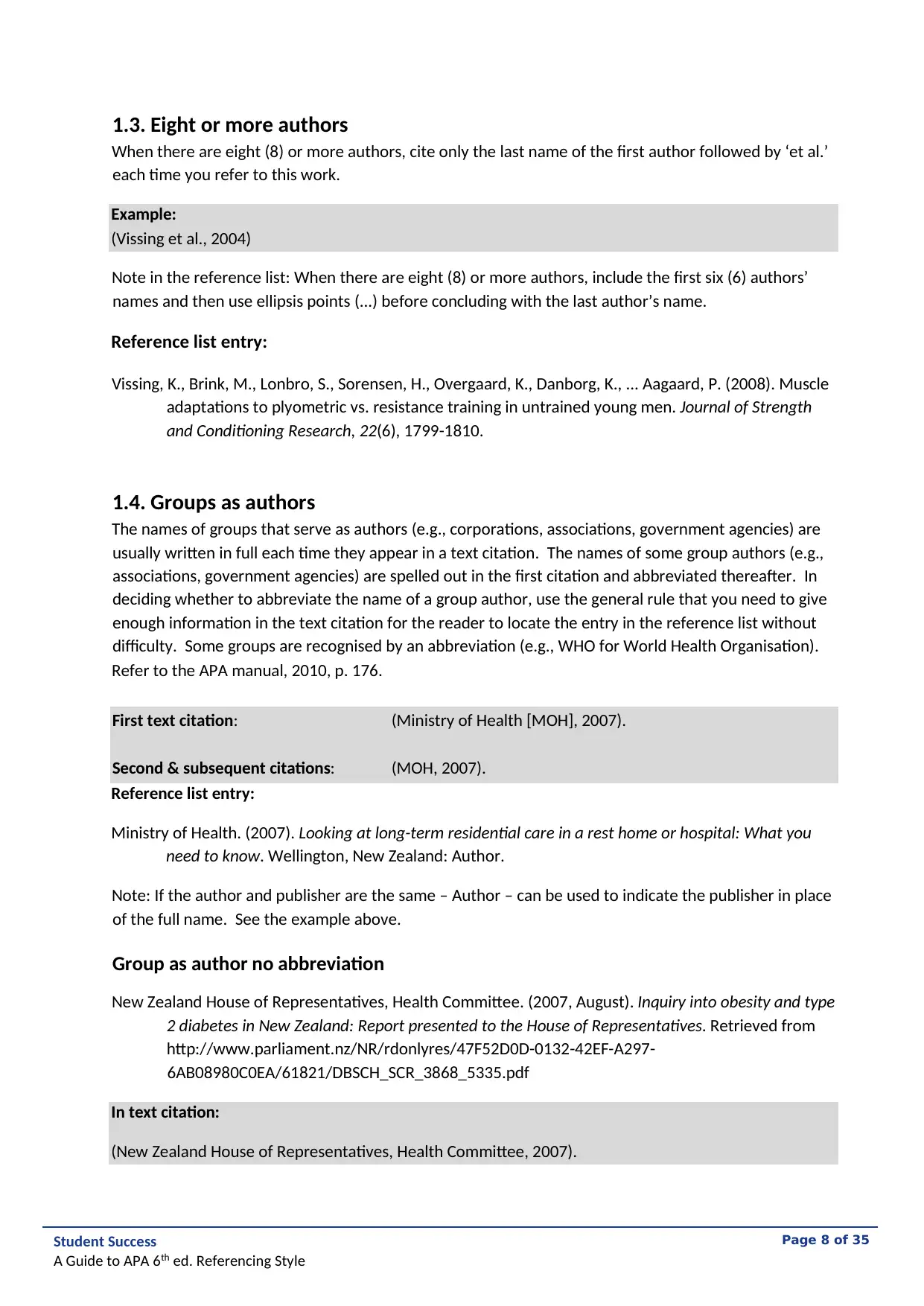
Student Success
A Guide to APA 6th ed. Referencing Style
Page 8 of 35
1.3. Eight or more authors
When there are eight (8) or more authors, cite only the last name of the first author followed by ‘et al.’
each time you refer to this work.
Example:
(Vissing et al., 2004)
Note in the reference list: When there are eight (8) or more authors, include the first six (6) authors’
names and then use ellipsis points (...) before concluding with the last author’s name.
Reference list entry:
Vissing, K., Brink, M., Lonbro, S., Sorensen, H., Overgaard, K., Danborg, K., ... Aagaard, P. (2008). Muscle
adaptations to plyometric vs. resistance training in untrained young men. Journal of Strength
and Conditioning Research, 22(6), 1799-1810.
1.4. Groups as authors
The names of groups that serve as authors (e.g., corporations, associations, government agencies) are
usually written in full each time they appear in a text citation. The names of some group authors (e.g.,
associations, government agencies) are spelled out in the first citation and abbreviated thereafter. In
deciding whether to abbreviate the name of a group author, use the general rule that you need to give
enough information in the text citation for the reader to locate the entry in the reference list without
difficulty. Some groups are recognised by an abbreviation (e.g., WHO for World Health Organisation).
Refer to the APA manual, 2010, p. 176.
First text citation: (Ministry of Health [MOH], 2007).
Second & subsequent citations: (MOH, 2007).
Reference list entry:
Ministry of Health. (2007). Looking at long-term residential care in a rest home or hospital: What you
need to know. Wellington, New Zealand: Author.
Note: If the author and publisher are the same – Author – can be used to indicate the publisher in place
of the full name. See the example above.
Group as author no abbreviation
New Zealand House of Representatives, Health Committee. (2007, August). Inquiry into obesity and type
2 diabetes in New Zealand: Report presented to the House of Representatives. Retrieved from
http://www.parliament.nz/NR/rdonlyres/47F52D0D-0132-42EF-A297-
6AB08980C0EA/61821/DBSCH_SCR_3868_5335.pdf
In text citation:
(New Zealand House of Representatives, Health Committee, 2007).
A Guide to APA 6th ed. Referencing Style
Page 8 of 35
1.3. Eight or more authors
When there are eight (8) or more authors, cite only the last name of the first author followed by ‘et al.’
each time you refer to this work.
Example:
(Vissing et al., 2004)
Note in the reference list: When there are eight (8) or more authors, include the first six (6) authors’
names and then use ellipsis points (...) before concluding with the last author’s name.
Reference list entry:
Vissing, K., Brink, M., Lonbro, S., Sorensen, H., Overgaard, K., Danborg, K., ... Aagaard, P. (2008). Muscle
adaptations to plyometric vs. resistance training in untrained young men. Journal of Strength
and Conditioning Research, 22(6), 1799-1810.
1.4. Groups as authors
The names of groups that serve as authors (e.g., corporations, associations, government agencies) are
usually written in full each time they appear in a text citation. The names of some group authors (e.g.,
associations, government agencies) are spelled out in the first citation and abbreviated thereafter. In
deciding whether to abbreviate the name of a group author, use the general rule that you need to give
enough information in the text citation for the reader to locate the entry in the reference list without
difficulty. Some groups are recognised by an abbreviation (e.g., WHO for World Health Organisation).
Refer to the APA manual, 2010, p. 176.
First text citation: (Ministry of Health [MOH], 2007).
Second & subsequent citations: (MOH, 2007).
Reference list entry:
Ministry of Health. (2007). Looking at long-term residential care in a rest home or hospital: What you
need to know. Wellington, New Zealand: Author.
Note: If the author and publisher are the same – Author – can be used to indicate the publisher in place
of the full name. See the example above.
Group as author no abbreviation
New Zealand House of Representatives, Health Committee. (2007, August). Inquiry into obesity and type
2 diabetes in New Zealand: Report presented to the House of Representatives. Retrieved from
http://www.parliament.nz/NR/rdonlyres/47F52D0D-0132-42EF-A297-
6AB08980C0EA/61821/DBSCH_SCR_3868_5335.pdf
In text citation:
(New Zealand House of Representatives, Health Committee, 2007).
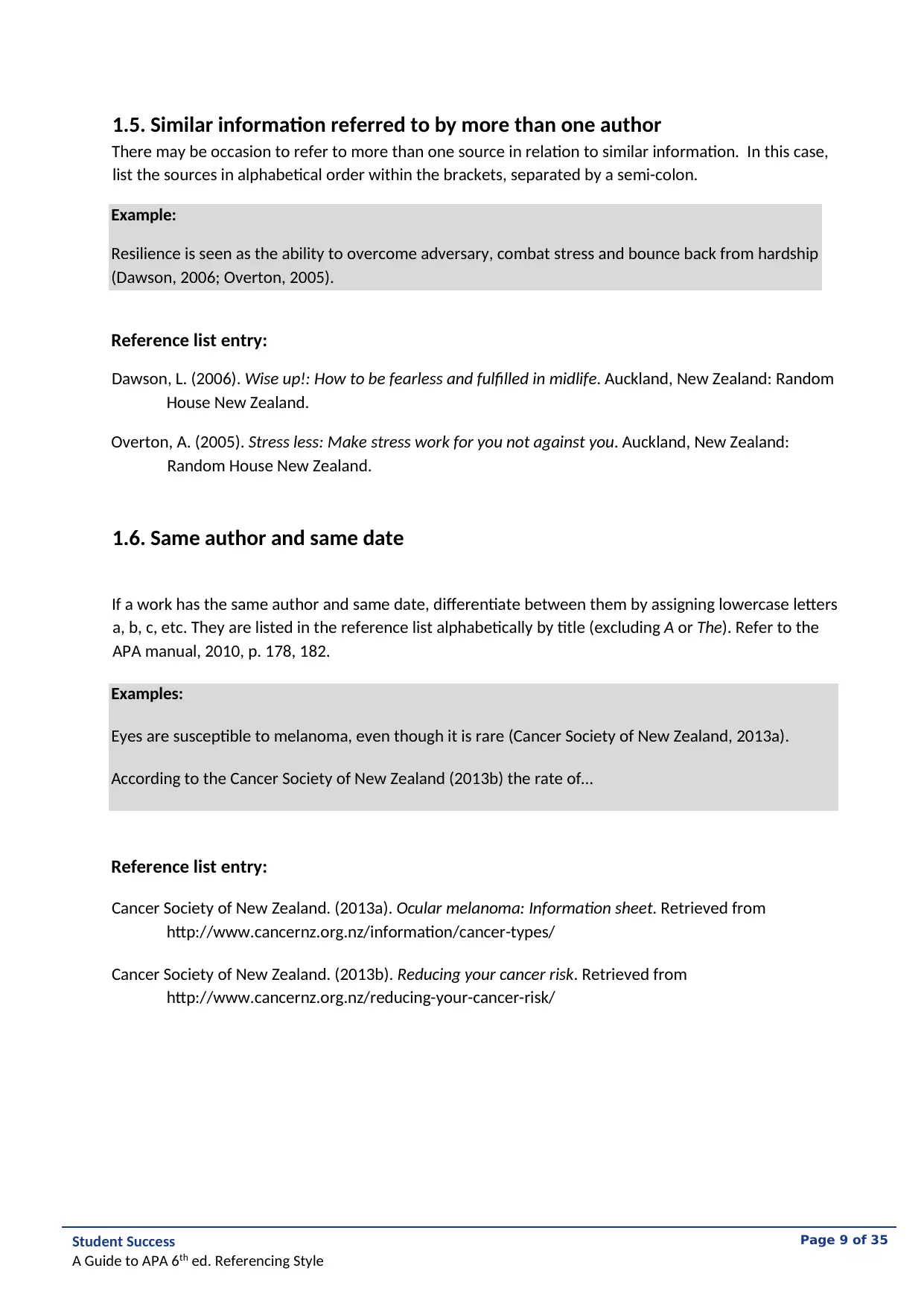
Student Success
A Guide to APA 6th ed. Referencing Style
Page 9 of 35
1.5. Similar information referred to by more than one author
There may be occasion to refer to more than one source in relation to similar information. In this case,
list the sources in alphabetical order within the brackets, separated by a semi-colon.
Example:
Resilience is seen as the ability to overcome adversary, combat stress and bounce back from hardship
(Dawson, 2006; Overton, 2005).
Reference list entry:
Dawson, L. (2006). Wise up!: How to be fearless and fulfilled in midlife. Auckland, New Zealand: Random
House New Zealand.
Overton, A. (2005). Stress less: Make stress work for you not against you. Auckland, New Zealand:
Random House New Zealand.
1.6. Same author and same date
If a work has the same author and same date, differentiate between them by assigning lowercase letters
a, b, c, etc. They are listed in the reference list alphabetically by title (excluding A or The). Refer to the
APA manual, 2010, p. 178, 182.
Examples:
Eyes are susceptible to melanoma, even though it is rare (Cancer Society of New Zealand, 2013a).
According to the Cancer Society of New Zealand (2013b) the rate of…
Reference list entry:
Cancer Society of New Zealand. (2013a). Ocular melanoma: Information sheet. Retrieved from
http://www.cancernz.org.nz/information/cancer-types/
Cancer Society of New Zealand. (2013b). Reducing your cancer risk. Retrieved from
http://www.cancernz.org.nz/reducing-your-cancer-risk/
A Guide to APA 6th ed. Referencing Style
Page 9 of 35
1.5. Similar information referred to by more than one author
There may be occasion to refer to more than one source in relation to similar information. In this case,
list the sources in alphabetical order within the brackets, separated by a semi-colon.
Example:
Resilience is seen as the ability to overcome adversary, combat stress and bounce back from hardship
(Dawson, 2006; Overton, 2005).
Reference list entry:
Dawson, L. (2006). Wise up!: How to be fearless and fulfilled in midlife. Auckland, New Zealand: Random
House New Zealand.
Overton, A. (2005). Stress less: Make stress work for you not against you. Auckland, New Zealand:
Random House New Zealand.
1.6. Same author and same date
If a work has the same author and same date, differentiate between them by assigning lowercase letters
a, b, c, etc. They are listed in the reference list alphabetically by title (excluding A or The). Refer to the
APA manual, 2010, p. 178, 182.
Examples:
Eyes are susceptible to melanoma, even though it is rare (Cancer Society of New Zealand, 2013a).
According to the Cancer Society of New Zealand (2013b) the rate of…
Reference list entry:
Cancer Society of New Zealand. (2013a). Ocular melanoma: Information sheet. Retrieved from
http://www.cancernz.org.nz/information/cancer-types/
Cancer Society of New Zealand. (2013b). Reducing your cancer risk. Retrieved from
http://www.cancernz.org.nz/reducing-your-cancer-risk/
⊘ This is a preview!⊘
Do you want full access?
Subscribe today to unlock all pages.

Trusted by 1+ million students worldwide
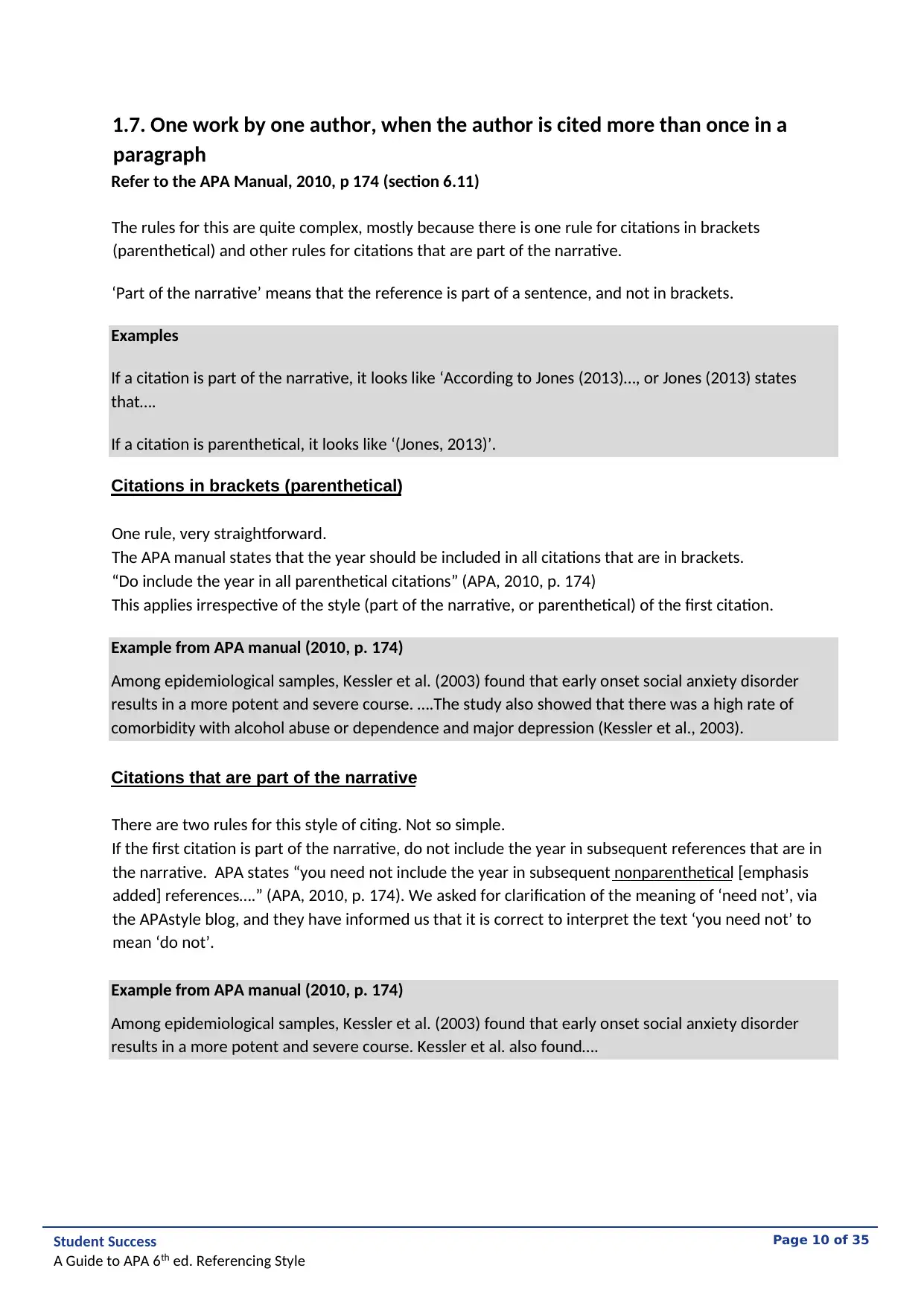
Student Success
A Guide to APA 6th ed. Referencing Style
Page 10 of 35
1.7. One work by one author, when the author is cited more than once in a
paragraph
Refer to the APA Manual, 2010, p 174 (section 6.11)
The rules for this are quite complex, mostly because there is one rule for citations in brackets
(parenthetical) and other rules for citations that are part of the narrative.
‘Part of the narrative’ means that the reference is part of a sentence, and not in brackets.
Examples
If a citation is part of the narrative, it looks like ‘According to Jones (2013)…, or Jones (2013) states
that….
If a citation is parenthetical, it looks like ‘(Jones, 2013)’.
Citations in brackets (parenthetical)
One rule, very straightforward.
The APA manual states that the year should be included in all citations that are in brackets.
“Do include the year in all parenthetical citations” (APA, 2010, p. 174)
This applies irrespective of the style (part of the narrative, or parenthetical) of the first citation.
Example from APA manual (2010, p. 174)
Among epidemiological samples, Kessler et al. (2003) found that early onset social anxiety disorder
results in a more potent and severe course. ….The study also showed that there was a high rate of
comorbidity with alcohol abuse or dependence and major depression (Kessler et al., 2003).
Citations that are part of the narrative
There are two rules for this style of citing. Not so simple.
If the first citation is part of the narrative, do not include the year in subsequent references that are in
the narrative. APA states “you need not include the year in subsequent nonparenthetical [emphasis
added] references….” (APA, 2010, p. 174). We asked for clarification of the meaning of ‘need not’, via
the APAstyle blog, and they have informed us that it is correct to interpret the text ‘you need not’ to
mean ‘do not’.
Example from APA manual (2010, p. 174)
Among epidemiological samples, Kessler et al. (2003) found that early onset social anxiety disorder
results in a more potent and severe course. Kessler et al. also found….
A Guide to APA 6th ed. Referencing Style
Page 10 of 35
1.7. One work by one author, when the author is cited more than once in a
paragraph
Refer to the APA Manual, 2010, p 174 (section 6.11)
The rules for this are quite complex, mostly because there is one rule for citations in brackets
(parenthetical) and other rules for citations that are part of the narrative.
‘Part of the narrative’ means that the reference is part of a sentence, and not in brackets.
Examples
If a citation is part of the narrative, it looks like ‘According to Jones (2013)…, or Jones (2013) states
that….
If a citation is parenthetical, it looks like ‘(Jones, 2013)’.
Citations in brackets (parenthetical)
One rule, very straightforward.
The APA manual states that the year should be included in all citations that are in brackets.
“Do include the year in all parenthetical citations” (APA, 2010, p. 174)
This applies irrespective of the style (part of the narrative, or parenthetical) of the first citation.
Example from APA manual (2010, p. 174)
Among epidemiological samples, Kessler et al. (2003) found that early onset social anxiety disorder
results in a more potent and severe course. ….The study also showed that there was a high rate of
comorbidity with alcohol abuse or dependence and major depression (Kessler et al., 2003).
Citations that are part of the narrative
There are two rules for this style of citing. Not so simple.
If the first citation is part of the narrative, do not include the year in subsequent references that are in
the narrative. APA states “you need not include the year in subsequent nonparenthetical [emphasis
added] references….” (APA, 2010, p. 174). We asked for clarification of the meaning of ‘need not’, via
the APAstyle blog, and they have informed us that it is correct to interpret the text ‘you need not’ to
mean ‘do not’.
Example from APA manual (2010, p. 174)
Among epidemiological samples, Kessler et al. (2003) found that early onset social anxiety disorder
results in a more potent and severe course. Kessler et al. also found….
Paraphrase This Document
Need a fresh take? Get an instant paraphrase of this document with our AI Paraphraser
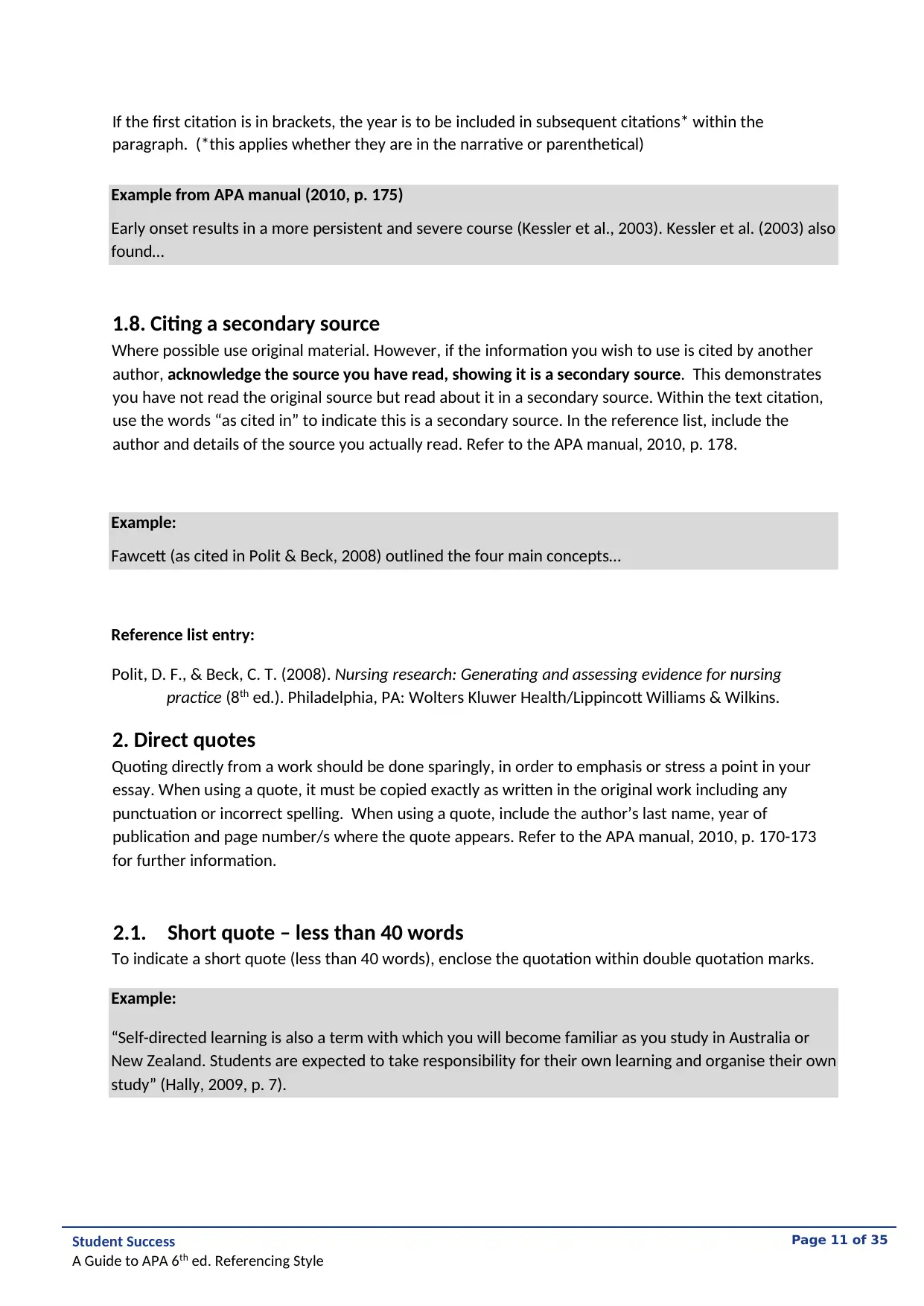
Student Success
A Guide to APA 6th ed. Referencing Style
Page 11 of 35
If the first citation is in brackets, the year is to be included in subsequent citations* within the
paragraph. (*this applies whether they are in the narrative or parenthetical)
Example from APA manual (2010, p. 175)
Early onset results in a more persistent and severe course (Kessler et al., 2003). Kessler et al. (2003) also
found…
1.8. Citing a secondary source
Where possible use original material. However, if the information you wish to use is cited by another
author, acknowledge the source you have read, showing it is a secondary source. This demonstrates
you have not read the original source but read about it in a secondary source. Within the text citation,
use the words “as cited in” to indicate this is a secondary source. In the reference list, include the
author and details of the source you actually read. Refer to the APA manual, 2010, p. 178.
Example:
Fawcett (as cited in Polit & Beck, 2008) outlined the four main concepts…
Reference list entry:
Polit, D. F., & Beck, C. T. (2008). Nursing research: Generating and assessing evidence for nursing
practice (8th ed.). Philadelphia, PA: Wolters Kluwer Health/Lippincott Williams & Wilkins.
2. Direct quotes
Quoting directly from a work should be done sparingly, in order to emphasis or stress a point in your
essay. When using a quote, it must be copied exactly as written in the original work including any
punctuation or incorrect spelling. When using a quote, include the author’s last name, year of
publication and page number/s where the quote appears. Refer to the APA manual, 2010, p. 170-173
for further information.
2.1. Short quote – less than 40 words
To indicate a short quote (less than 40 words), enclose the quotation within double quotation marks.
Example:
“Self-directed learning is also a term with which you will become familiar as you study in Australia or
New Zealand. Students are expected to take responsibility for their own learning and organise their own
study” (Hally, 2009, p. 7).
A Guide to APA 6th ed. Referencing Style
Page 11 of 35
If the first citation is in brackets, the year is to be included in subsequent citations* within the
paragraph. (*this applies whether they are in the narrative or parenthetical)
Example from APA manual (2010, p. 175)
Early onset results in a more persistent and severe course (Kessler et al., 2003). Kessler et al. (2003) also
found…
1.8. Citing a secondary source
Where possible use original material. However, if the information you wish to use is cited by another
author, acknowledge the source you have read, showing it is a secondary source. This demonstrates
you have not read the original source but read about it in a secondary source. Within the text citation,
use the words “as cited in” to indicate this is a secondary source. In the reference list, include the
author and details of the source you actually read. Refer to the APA manual, 2010, p. 178.
Example:
Fawcett (as cited in Polit & Beck, 2008) outlined the four main concepts…
Reference list entry:
Polit, D. F., & Beck, C. T. (2008). Nursing research: Generating and assessing evidence for nursing
practice (8th ed.). Philadelphia, PA: Wolters Kluwer Health/Lippincott Williams & Wilkins.
2. Direct quotes
Quoting directly from a work should be done sparingly, in order to emphasis or stress a point in your
essay. When using a quote, it must be copied exactly as written in the original work including any
punctuation or incorrect spelling. When using a quote, include the author’s last name, year of
publication and page number/s where the quote appears. Refer to the APA manual, 2010, p. 170-173
for further information.
2.1. Short quote – less than 40 words
To indicate a short quote (less than 40 words), enclose the quotation within double quotation marks.
Example:
“Self-directed learning is also a term with which you will become familiar as you study in Australia or
New Zealand. Students are expected to take responsibility for their own learning and organise their own
study” (Hally, 2009, p. 7).
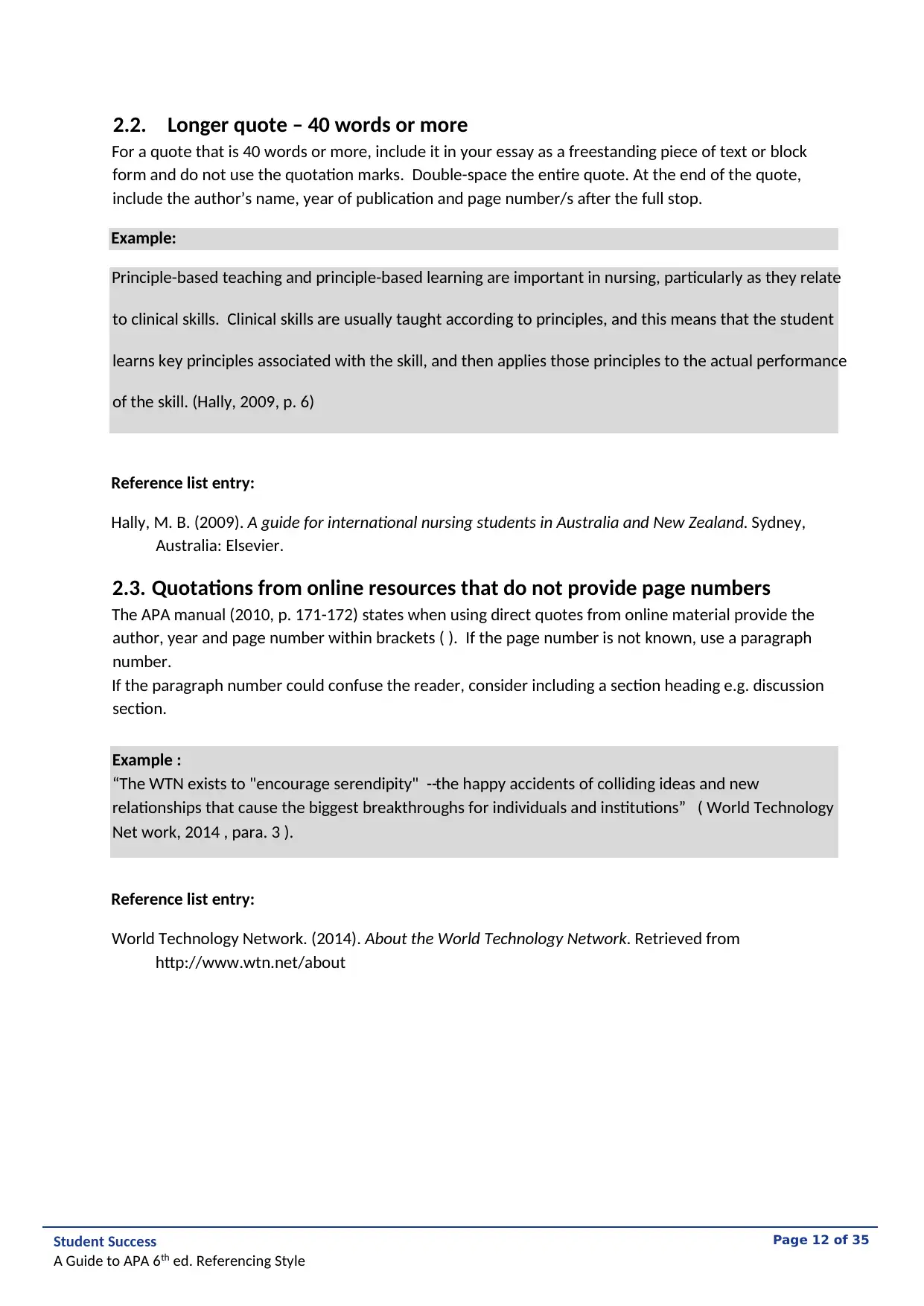
Student Success
A Guide to APA 6th ed. Referencing Style
Page 12 of 35
2.2. Longer quote – 40 words or more
For a quote that is 40 words or more, include it in your essay as a freestanding piece of text or block
form and do not use the quotation marks. Double-space the entire quote. At the end of the quote,
include the author’s name, year of publication and page number/s after the full stop.
Example:
Principle-based teaching and principle-based learning are important in nursing, particularly as they relate
to clinical skills. Clinical skills are usually taught according to principles, and this means that the student
learns key principles associated with the skill, and then applies those principles to the actual performance
of the skill. (Hally, 2009, p. 6)
Reference list entry:
Hally, M. B. (2009). A guide for international nursing students in Australia and New Zealand. Sydney,
Australia: Elsevier.
2.3. Quotations from online resources that do not provide page numbers
The APA manual (2010, p. 171-172) states when using direct quotes from online material provide the
author, year and page number within brackets ( ). If the page number is not known, use a paragraph
number.
If the paragraph number could confuse the reader, consider including a section heading e.g. discussion
section.
Reference list entry:
World Technology Network. (2014). About the World Technology Network. Retrieved from
http://www.wtn.net/about
Example :
“The WTN exists to "encourage serendipity" --the happy accidents of colliding ideas and new
relationships that cause the biggest breakthroughs for individuals and institutions” ( World Technology
Net work, 2014 , para. 3 ).
A Guide to APA 6th ed. Referencing Style
Page 12 of 35
2.2. Longer quote – 40 words or more
For a quote that is 40 words or more, include it in your essay as a freestanding piece of text or block
form and do not use the quotation marks. Double-space the entire quote. At the end of the quote,
include the author’s name, year of publication and page number/s after the full stop.
Example:
Principle-based teaching and principle-based learning are important in nursing, particularly as they relate
to clinical skills. Clinical skills are usually taught according to principles, and this means that the student
learns key principles associated with the skill, and then applies those principles to the actual performance
of the skill. (Hally, 2009, p. 6)
Reference list entry:
Hally, M. B. (2009). A guide for international nursing students in Australia and New Zealand. Sydney,
Australia: Elsevier.
2.3. Quotations from online resources that do not provide page numbers
The APA manual (2010, p. 171-172) states when using direct quotes from online material provide the
author, year and page number within brackets ( ). If the page number is not known, use a paragraph
number.
If the paragraph number could confuse the reader, consider including a section heading e.g. discussion
section.
Reference list entry:
World Technology Network. (2014). About the World Technology Network. Retrieved from
http://www.wtn.net/about
Example :
“The WTN exists to "encourage serendipity" --the happy accidents of colliding ideas and new
relationships that cause the biggest breakthroughs for individuals and institutions” ( World Technology
Net work, 2014 , para. 3 ).
⊘ This is a preview!⊘
Do you want full access?
Subscribe today to unlock all pages.

Trusted by 1+ million students worldwide
1 out of 35
Your All-in-One AI-Powered Toolkit for Academic Success.
+13062052269
info@desklib.com
Available 24*7 on WhatsApp / Email
![[object Object]](/_next/static/media/star-bottom.7253800d.svg)
Unlock your academic potential
Copyright © 2020–2025 A2Z Services. All Rights Reserved. Developed and managed by ZUCOL.


